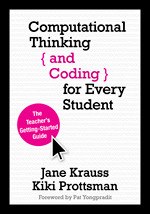Computational Thinking and Coding for Every Student
The Teacher’s Getting-Started Guide
- Jane Krauss - University of Oregon, USA
- Kiki Prottsman
Foreword by Pat Yongpradit of Code.org
Download a free chapter!
Empower tomorrow’s tech innovators
Our students are avid users and consumers of technology. Isn’t it time that they see themselves as the next technological innovators, too? Computational Thinking and Coding for Every Student is the beginner’s guide for K-12 educators who want to learn to integrate the basics of computer science into their curriculum. Readers will find
- Practical strategies for teaching computational thinking and the beginning steps to introduce coding at any grade level, across disciplines, and during out-of-school time
- Instruction-ready lessons and activities for every grade
- Specific guidance for designing a learning pathway for elementary, middle, or high school students
- Justification for making coding and computer science accessible to all
- A glossary with definitions of key computer science terms, a discussion guide with tips for making the most of the book, and companion website with videos, activities, and other resources
Momentum for computer science education is growing as educators and parents realize how fundamental computing has become for the jobs of the future. This book is for educators who see all of their students as creative thinkers and active contributors to tomorrow’s innovations.
“Kiki Prottsman and Jane Krauss have been at the forefront of the rising popularity of computer science and are experts in the issues that the field faces, such as equity and diversity. In this book, they’ve condensed years of research and practitioner experience into an easy to read narrative about what computer science is, why it is important, and how to teach it to a variety of audiences. Their ideas aren’t just good, they are research-based and have been in practice in thousands of classrooms…So to the hundreds and thousands of teachers who are considering, learning, or actively teaching computer science—this book is well worth your time.”Pat Yongpradit
Chief Academic Officer, Code.org
"Change in education and schooling comes in waves, and coding, computer science, and computational thinking represent the next very big wave. This very readable book will introduce teachers, parents and students to the future."
This book will help a lot of educators take their first steps toward bringing high quality programming experiences to their students. It offers clear examples
and good strategies supported by research and best practices.
Wondering whether this book is for you? Check out the “dos and don’ts” of Chapter 5 and then take them to heart. I did!
This book is so clear and so encouraging. I recommend it to my Girls Excelling in Math and Science (GEMS) leaders as we work to incorporate more computer science into our activities. The authors present a comprehensive introduction to computing in a way that’s useful, readable, and fun.
Sample Materials & Chapters
Chapter 1 - An Introduction to Computer Science
Chapter 3 - Try Your Hand at Coding
